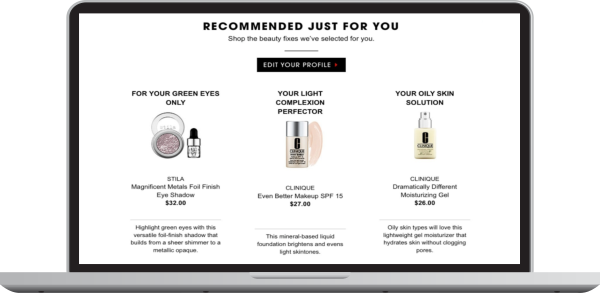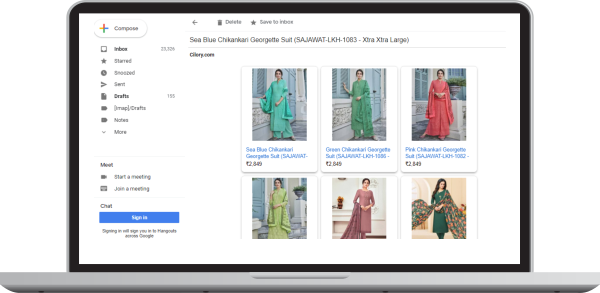Most Ecommerce brands now heavily rely on data patterns created by users to keep their consumers engaged with effective ecommerce product recommendation strategies.
Recommendation engines powered by Artificial Intelligence and Machine Learning work the same magic for generating content and providing product recommendations. These recommendations become even more compelling when they are personalized to each user.
An Accenture report suggests that “personalized recommendations increase chances of conversion by 75%”.
A Salesforce study revealed “product recommendations account for only 7% of ecommerce traffic but make up for 24% of orders and 26% of revenue.”
56% percent of online customers prefer visiting sites that offer intelligent recommendations, and businesses that personalize their web experiences see a 19% uplift in sales.
Thus, it’s important to know the best product recommendation practices ecommerce experts are using for customer acquisition and boosting their lifetime value.
Top Ecommerce Product Recommendation Strategies
Here are some of the most intelligent personalized and non-personalized recommendation practices that will help you sell more products more often.
Personalized Recommendations
1. “Recommended For you”- Based on browsing history
This is one of the most impactful and common types of product recommendations based on your visitor’s browsing history, actions, location, device, add-to-cart choices, likes, or favorites.
These recommendations are either relevant or alternative to the products that were recently viewed. Customers love seeing products that match their tastes or preferences. Also, alternative products allow your customers to make comparisons.

2. “You might also like” – The classic way to cross-sell
These options usually allow you to choose similar products from different brands, styles, colors, and price ranges. You will be spoiled for choices, but most likely, you will end up making an informed decision.
The reason? People landing on product pages are usually open to more choices as they are still in search mode. Use the opportunity slip in alternative or relevant items by setting a dynamic up-selling or cross-selling filter via your recommendation engine.

3. Personalize your Search Pages – To individualize the web or App viewing experience
If your returning customer has landed on your search page of a specific product category, the best bet for you is to dynamically push items from their search history above the fold in that particular category.
This will personalize their site or App viewing experience and also individualize their buying journey, creating a complete 1-to-1 experience with your brand.
4. Personalize email campaigns using the recommendation engine
Your Omni-channel personalization engine will know the search history of your customers. Use the data patterns created by the engine in your email marketing campaigns to remarket the products your visitors are likely to buy.
Searching for kurtas on cilory.com eventually led to remarketing the same designs through email marketing. Such personalized recommendations on email definitely strike a cord and can help generate massive revenue for your e-commerce store.

5. Personalize recommendations based on purchase history
Recommendations based on purchase history are an investment in your customer’s lifetime value. For example, if your customer frequently buys skincare products from your e-store, you can always make similar recommendations from other brands based on high ratings or popularity.
These are more of “you might also like” ecommerce product recommendation options where you upsell the kind of products that match your customer style. It’s crucial to analyze the right behavior to make such behavioral-based recommendations.
If your customer likes to buy clothes made from eco-friendly fiber, you would want to consider recommending other environmentally friendly or green products to uplift customer retention and conversions.
6. Focus on personalizing your shopping cart extensively
Your customer is about to check out. They are in a very favorable and elevated emotional state. This is your prime time for upselling and your last chance to increase the AOV (average order value).
You have ample information about your customers after they’ve completed a certain number of steps in the journey, enabling you to tailor your recommendations as personally as possible.
- You can always recommend products they have previously viewed, maybe under the title “Did you forget something?”
- Offer similar products other shoppers purchased or items related to their previous orders
- By this stage, you’re aware of their preferred product categories, price range, and brand preferences, so showcase items that align with their tastes.
Up to 25% of customers who click on these recommendations actually order the item. It’s also the perfect time to add complementary items to the cart.
A study conducted by Salesforce says, “Shoppers that clicked on recommendations are 4.5x more likely to add items to cart, and 4.5x more likely to complete their purchase.”
Free shipping incentives can also be a strong, decisive factor in adding recommended products in the cart.

7. Newly upgraded item version on sale
This is yet another compelling way to personalize the shopping experience. If your customer has bought an iWatch, you must keep them updated with the latest iWatch series as soon as you have it in stock.
8. Use 404 Errors and Out of stock pages for recommendations
Let’s accept it; such errors while shopping online can be a real mood killer. Now that you’re equipped with numerous product recommendation examples consider utilizing them on your website or app’s error pages. Error pages can be an opportunity to display
- “Recommended for you” products (based on behavior or browsing history)
- Bestsellers to keep your customers engaged
- Items related to browsing history
Non-Personalized Recommendations
9. The classic – Promote your best-sellers
“80% of a company’s profits tend to come from 20% of the products sold”.
Now, who does not want to see the best of the lot? You don’t even need advanced-level tracking for this. Your recommendations engine can help keep track of your most popular products and make recommendations under the “Best Seller” label. The “bestseller” items can also add social proof, which will help you drive conversions.
Your “top seller” recommendations are likely to drive sales from first-time visitors who may or may not what they are looking for. Since you haven’t collected any behavioral data from your first-time visitors, this calls for showcasing items that have a proven rate of conversion.
According to Baymard Institute’s research, 25% of test visitors scour up and down the homepage to take a quick review of the site’s product offerings, making your homepage the most crucial page for highlighting your “top seller” items.
The popular ecommerce website Etsy helps its customers catch up to the latest trends by showcasing trendy items under the banner “popular right now” on their homepage.

10. “Frequently bought together” – The practical approach
Many a time, customers don’t know the best combination of items. Some of the best e-commerce sites, like Flipkart and Amazon, cross-sell relevant products to increase Average Order Value (AOV).
The simplest example of this could be if your customer buys an expensive camera, you can always include a camera bag and memory card in your “frequently bought together” tab. You are not only selling more items and making more profits but also enhancing your customer’s buying experience.

11. Use Recommendation popups
Ecommerce product recommendation popups are not very common. So this may give you an edge. Depending on where your customers are in their buying cycle, you can guide them in the right direction. Recommendation Popups can work best for your top sellers or seasonal sellers.
NY Forms, a Danish website specializing in sports and leisure clothing, does this well. On their category page of fleeces, I came across a slide-in popup saying “the must-haves of the season for women.”
Once you click on that, it will show three bestselling items related to fleeces. And once you click on the CTA, it will take you to the product page for more details.




12. Use the power of titles
A lot of ecommerce websites use impressively creative titles to grab your attention. A website called Headphone Zone nails the kind of recommendations they make on their home page.
A lot of users don’t know what kind of headphones suits them best, and to make sure they sell the right product to the right people, the website has this recommendation called “Can We Help You Pick a Headphone?”
Also, they have this title recommendation called “Audiophiles Stop Here” for hardcore music enthusiasts who might be looking for the best of the lot.
Another interesting recommendation title is “Working From Home?” Now this one is quite impactful, knowing a lot of people must have invested in buying decent headphones while working from home.
So don’t underestimate the power of titles when making recommendations to your users.


Summing Up
75% of online customers prefer a personalized shopping experience. Don’t let them down. You can individualize customer experience at scale by incorporating product recommendations on all the relevant sections of your site or App with the help of captivating titles.
Some of our customers have seen a 16X increase in ROI and a 7% increase in conversions with advanced dynamic personalization. To truly scale your marketing efforts, consider leveraging a robust ecommerce marketing platform. Book a demo today to discover how it can transform your business.
With customers increasingly favoring online shopping, it’s the ideal time to leverage product recommendations. This approach not only attracts them but also demonstrates your commitment to their preferences.







